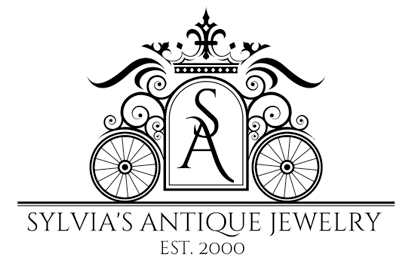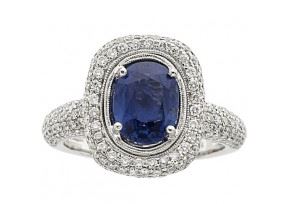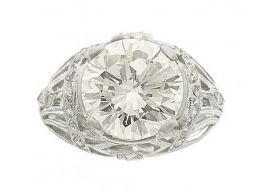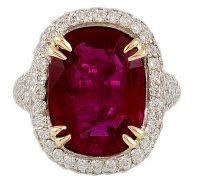The early 1930s heralded a new-found interest in diamond jewelry and because of the vast diamonds mines discovered in South Africa diamonds were becoming increasingly available for everyone. Hollywood was huge in dictating new styles and influencing its new fans. Mega-movie stars of the 1930s such as Gloria Swanson and Mae West loved to wear opulent jewelry and were themselves avid collectors. Harry Winston opened his first retail store in New York City in 1932. His firm would become famous for buying the biggest gemstones in the world, including the fancy blue Hope Diamond, which was 45.42 carats and the 601 carat rough Lesotho Diamond.
But all of this was to hit a major roadblock with the outbreak of the Second World War and the industry’s fast paced development of new jewelry making techniques, innovations, stones and metals were brought to an almost abrupt halt. The U.S. government rationed gold and barred stones from Europe and Asia from coming into the country. Jewelry design took on more of an American style, as European companies were forced to shut down during the war. The use of platinum was also prohibited as it was mandated to be used in war equipment, so sterling silver took over as the metal of choice. Jewelers were forced to re-think their suppliers and tighten their belts. As a result, less expensive gemstones from South Africa such as aquamarines and tourmalines became increasingly used. Wartime austerity meant that the whims of fashion and taste were forced to take second place to practicality. Materials were simply too hard to come by. It was not that jewelry downsized dramatically and became unattractive; in fact pieces from the 1930s were glamorous, oversized and sophisticated in appearance particularly because of the increasing influence of Hollywood. Many actresses of the time appeared in promotional advertisements for the jewelry they wore in their movies. It was just that the materials and gemstones used were less expensive. Look for masculine, square shaped cocktail rings with bold jewels which are striking and dramatic in design. In 1936, even Hollywood was upstaged when King Edward VIII abdicated so he could marry Wallis Simpson. The Duke and Duchess of Windsor (as they came to be known) were renowned for their collection of bold, unusual jewelry. The most famous of the Duchess' Retro jewels were made by Cartier and Van Cleef & Arpels.
The war in Europe influenced jewelry design, so that you will often see military or Machine Age themes reflected in the pieces. Clever design work substituted small and hard-to-come-by precious stones with larger semi-precious ones to create the look of luxury at a lower price. So what was the actual type of jewelry worn in the 1930s and 40s? Long pendants, dress clips, brooches, cocktail rings, of course, and bangle bracelets were the most fashionable. If you have been to an estate sale recently, or to one of the thousands of vintage stores that have become increasingly popular in recent years, you may still be able to find good examples of these collectible Retro pieces.
A major change in 1930s jewelry was the use of Bakelite, a type of plastic, which was already being used in household items such as kitchenware. As costume jewelry, Bakelite was most used during the Great Depression and could imitate the look of tortoiseshell, coral, amber, ivory and other more costly materials. It was versatile, cheap and could be made into any number of attractive pieces. Bakelite has a great deal of good vintage specimens remaining. The most valuable are those that are the brightest in color, are highly carved and are large in size. Real Bakelite was most often either pea-green or butterscotch in color and it has a slight smell of formaldehyde, so beware of fakes!
The United States entered the War in 1941 after the bombing of Pearl Harbor. American Retro Jewelry was whimsical, escapist and delightful. Birds, baskets of flowers, dancers and other serene images were common motifs. Animals, shells and hearts were also recurrent designs in jewels of the period, often accented with sprays of diamonds and twists. Clips and brooches of the time were huge. Another popular jewelry trend from the 1940s were pins that were worn on hats, scarves or collars. They were most often made of sterling silver, colored gold and sometimes precious stones and were in the shape of animals, clowns or ballerinas. They are great collectors’ items today and can command high prices. Retro jewelry has become very collectible. Until the 1970s, jewelry from the 40's and 50's was often sold for scrap value and melted down. The examples of Retro jewelry that survive today are highly coveted. The value of Retro pins, clips, bracelets and rings has seriously appreciated in recent years, and the trend is not expected to crest in the foreseeable future.
To get a taste of 1930s and 1940s glamour, Sylvia’s Antique Jewelry invites you to take a tour of our retro jewelry collection and choose your favorite look from the past. It is easy to indulge in whatever suits your fancy.
For information on Retro Style Jewelry please call us at 800-969-6930 or Email Us































 1.800.969.6930
1.800.969.6930  Live chat
Live chat 